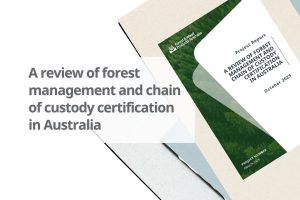From its base at the University of the Sunshine Coast (USC), the Centre’s team takes a national and international approach. Aside from the support of FWPA, other significant investing partners include the University of Queensland (UQ) and the Queensland Department of Agriculture and Fisheries (DAF).
“During the past three years, the Centre has made great inroads in working with industry to ensure Australia has access to the world’s leading research and best practice, while building strong links between industry, academia and customers,” said FWPA Acting CEO Dr Chris Lafferty.
“The centre has made exceptional progress in engaging research partners and initiating a range of new research projects, despite the disruption caused over the last two years by COVID-19.”
A major goal announced by the Centre upon its launch in 2017 was the development of a predictive, evidence-based model to enable architects and building specifiers to choose the right timber for the right task more easily, accurately forecasting structural performance and design life.
This goal represents an extension of earlier work conducted by the CSIRO, resulting in the development of a model that, although ground-breaking, lacked robust data. The Centre is therefore involved with numerous research projects and field trials to add extra data, while also encouraging other owners of industry statistics to share and help strengthen the model.
Setting the research agenda
The team has orchestrated a range of stakeholder meetings at premises across the country to discuss the Centre’s operations, objectives and projects with key industry stakeholders, as well as to answer questions and identify pressing research priorities. These consultations have guided the initiation of more than 20 exciting new research projects.
Research to date has focused on treated wood quality, fire impact, timber field performance, termite biology, moisture behaviour, coatings performance and much more.
Important partnerships
Since the Centre’s launch, the team has established a number of key industry partnerships, including a cooperative project with the University of Tasmania (UTAS) under the National Institute for Forest Products (NIFPI) program, to evaluate methods for enhancing the durability of plantation and native forest hardwoods.
In addition, the Centre has partnered with the NIFPI Hub at the University of South Australia (UniSA) on a treatability assessment of the pine resource across Australia. A preliminary trial has already been conducted, and test samples are now being prepared for a full-scale trial that will aim to provide a roadmap for treatability of the Australian softwood resource.
The UniSA/NIFPI partnership has also resulted in work to determine the validity of the current machine graded pine (MGP) grading system. The treatment trials provide an opportunity to utilise some of this resource to provide further information to timber producers.
Meanwhile, a partnership with UQ was established and engaged fire science expert Dr Felix Wiesner and chemical engineer Dr Luis Yerman as Lecturer and Research Fellow, respectively. Each have recruited a PhD student to support their work.
Dr Wiesner is using his skills to explore improving fire durability, especially in bushfire-prone areas. His work has focused on partnering with several commercial entities, including a local hardwood producer, to develop fire performance data on Far North Queensland hardwoods.
Dr Wiesner has also successfully engaged with chemical suppliers regarding the potential for increased fire-retardant use, as well as gathering valuable insights around smoldering that could inform new approaches to the protective treatments of timber used externally in bushfire-prone areas and help limit the risk of further damage. The latter project is focused on the fire-performance of copper chrome arsenate (CCA) treated timber.
Meanwhile, Dr Yerman has completed a research project exploring the effects of repeated moisture cycling on connector capacity and is currently working on a larger study to examine the effects of fungal attack on nail performance. The results of this work will help building surveyors to assess the impacts of wetting and fungal attack on connectors.
Elsewhere, a three-year research plan was developed with DAF, resulting in a new field test site being established at the Maroochy Research Facility in Nambour. Data collected during field trials at this site will be used to improve upon the CSIRO service-life prediction models when it comes to various timber materials used for outdoor applications that are above ground and exposed to the weather.
This work also includes the testing of a wide range of new preservatives and preservative-treated composites, involving more than 8,000 test pieces. The results will help determine if these newer materials are fit for purpose under Australian conditions.
The Centre’s DAF partnership has also resulted in research into:
- the marine performance of new treatments
- moisture intrusion in mass timber buildings
- accelerated decay resistance testing
- the performance of utility poles
- above-ground decking performance
- the potential for using portable X-ray fluorescence analysers for the rapid field assessment of preservative retentions.
A growing team
During its first three years, the Centre has enjoyed rapid expansion in terms of the number of experts and students who have joined, both locally and from all over the world.
Significant appointments have included Dr Babar Hassan, who joined as Research Fellow, bringing extensive experience on termite biology.
Since commencing his role, Dr Hassan has been engaged in work to obtain data on termite distribution to help update CSIRO termite risk maps, and thus help local councils plan for termite protection in construction. He has also been working on a major review of termite testing methods, as well as a research project to uncover more about the West Indian drywood termite (WIDT), also known as Cryptotermes brevis.
In addition, Dr Hassan has been actively engaged with the Centre’s UTAS partners to explore new methods for enhancing the durability of refractory hardwoods — meaning those that are difficult to treat with preservatives — for above ground applications.
An important aspect of the Centre’s development has been the establishment of collaborative arrangements with scientists at other institutions. As a result, a number of researchers have joined as adjunct faculty members, including:
- Dr Saeed Mahini of UQ, who brings expertise in timber engineering
- Professor Greg Nolan of UTAS, who is leading a group working to improve utilisation of Tasmanaian hardwoods
- Mr Jack Norton, who has more than 40 years of experience in preservative treatment and serves as the Secretary of the Timber Preservers Association of Australasia
- Dr Lisa Ottenhaus, Lecturer at the UQ, who has extensive experience with timber connections and is focused on the effects of moisture and decay on connector behavior
- Mr. Michael Powell who has extensive experience working with electric utilities and will collaborate on the establishment of a Utility Pole Research Cooperative.
·
“A critical KPI is to repopulate industry research capacity in Australia,” explained Lafferty.
“In that respect, one of the most exciting aspects of the Centre’s work so far has been the number of post-graduates we now have on board.
“Thanks to its partnership with the Centre, the USC now has seven students enrolled — one master’s student and the others PhD. Six of these students are Australia-based and, upon completion, will boost local capacity in a number of areas.
“We have also recruited one Australian Centre for International Agricultural Research (ACIAR) Pacific Agriculture Scholarships and Support Program student who is currently based in PNG, and whose arrival has been held up by COVID-19 restrictions.”
Sharing knowledge
In addition to its focus on conducting and supporting research, the Centre has hosted multiple industry workshops on a variety of topics, with presentations given by local and international experts. Staff have also presented at various industry conferences and contributed knowledge towards several peer-reviewed papers.
The Centre hopes to host the Society of Wood Science and Technology meeting in July 2022. This meeting will bring together more than 250 wood scientists from around the world.
In 2023, the Centre will host the International Research Group on Wood Protection meeting in Cairns and will partner with UQ to host the 2025 World Conference on Timber Engineering in Brisbane. Bringing these international events to Australia will highlight the many important activities underway domestically.
Looking to the future
“The Centre has already led some vital research projects which have provided significant value to the Australian forestry and wood products industry and is well on its way to meeting its objective of helping to educate a new generation of durability researchers,” said Lafferty.
The FWPA Board is currently in the process of confirming the continuation of the Centre beyond its initial five years. It is expected to recommend a new five-year contract, with the possibility of a further three-year extension beyond that.



